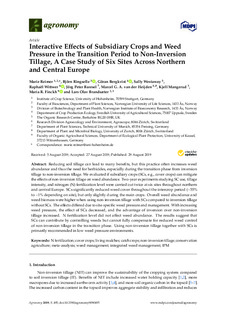| dc.contributor.author | Reimer, Marie | |
| dc.contributor.author | Ringselle, Björn | |
| dc.contributor.author | Bergkvist, Göran | |
| dc.contributor.author | Westaway, Sally | |
| dc.contributor.author | Wittwer, Raphaël | |
| dc.contributor.author | Baresel, Jörg Peter | |
| dc.contributor.author | van der Heijden, Marcel G. A. | |
| dc.contributor.author | Mangerud, Kjell | |
| dc.contributor.author | Finckh, Maria R. | |
| dc.contributor.author | Brandsæter, Lars Olav | |
| dc.date.accessioned | 2019-09-17T08:29:11Z | |
| dc.date.available | 2019-09-17T08:29:11Z | |
| dc.date.created | 2019-09-09T11:37:49Z | |
| dc.date.issued | 2019-08-29 | |
| dc.identifier.issn | 2073-4395 | |
| dc.identifier.uri | http://hdl.handle.net/11250/2617143 | |
| dc.description.abstract | Reducing soil tillage can lead to many benefits, but this practice often increases weed abundance and thus the need for herbicides, especially during the transition phase from inversion tillage to non-inversion tillage. We evaluated if subsidiary crops (SCs, e.g., cover crops) can mitigate the effects of non-inversion tillage on weed abundance. Two-year experiments studying SC use, tillage intensity, and nitrogen (N) fertilization level were carried out twice at six sites throughout northern and central Europe. SCs significantly reduced weed cover throughout the intercrop period (−55% to −1% depending on site), but only slightly during the main crops. Overall weed abundance and weed biomass were higher when using non-inversion tillage with SCs compared to inversion tillage without SCs. The effects differed due to site-specific weed pressure and management. With increasing weed pressure, the effect of SCs decreased, and the advantage of inversion over non-inversion tillage increased. N fertilization level did not affect weed abundance. The results suggest that SCs can contribute by controlling weeds but cannot fully compensate for reduced weed control of non-inversion tillage in the transition phase. Using non-inversion tillage together with SCs is primarily recommended in low weed pressure environments. | nb_NO |
| dc.description.abstract | Interactive Effects of Subsidiary Crops and Weed Pressure in the Transition Period to Non-Inversion Tillage, A Case Study of Six Sites Across Northern and Central Europe | nb_NO |
| dc.language.iso | eng | nb_NO |
| dc.rights | Navngivelse 4.0 Internasjonal | * |
| dc.rights.uri | http://creativecommons.org/licenses/by/4.0/deed.no | * |
| dc.subject | N fertilization | nb_NO |
| dc.subject | Cover crops; | nb_NO |
| dc.subject | Living mulches | nb_NO |
| dc.subject | Cath crops | nb_NO |
| dc.subject | Non-inversion tillage | nb_NO |
| dc.subject | Conservation agriculture | nb_NO |
| dc.subject | Meta-analysis | nb_NO |
| dc.subject | Weed management | nb_NO |
| dc.subject | Integrated weed management | nb_NO |
| dc.subject | IPM | nb_NO |
| dc.title | Interactive Effects of Subsidiary Crops and Weed Pressure in the Transition Period to Non-Inversion Tillage, A Case Study of Six Sites Across Northern and Central Europe | nb_NO |
| dc.type | Journal article | nb_NO |
| dc.type | Peer reviewed | nb_NO |
| dc.description.version | publishedVersion | nb_NO |
| dc.rights.holder | © 2019 by the authors. | nb_NO |
| dc.subject.nsi | VDP::Landbruks- og Fiskerifag: 900 | nb_NO |
| dc.source.volume | 9 | nb_NO |
| dc.source.journal | Agronomy | nb_NO |
| dc.identifier.doi | 10.3390/agronomy9090495 | |
| dc.identifier.cristin | 1722740 | |
| cristin.unitcode | 7677,3,0,0 | |
| cristin.unitcode | 7677,0,0,0 | |
| cristin.unitname | Divisjon for bioteknologi og plantehelse | |
| cristin.unitname | Norsk institutt for bioøkonomi | |
| cristin.ispublished | true | |
| cristin.qualitycode | 1 | |

